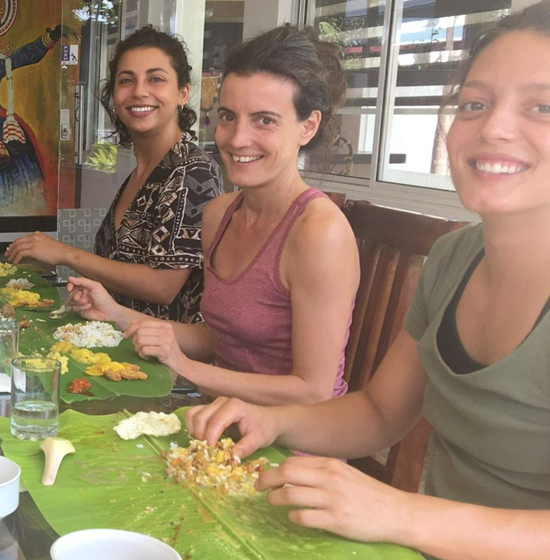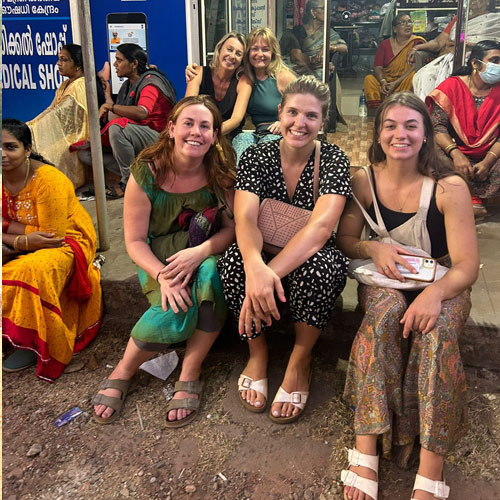Namaste is the ending of any yoga session and if you’ve been to one, you must be aware of it. Namaste is a Sanskrit language word which is used as a greeting or a respectful gesture, especially to an elderly person. It comes along with the action of joining both hands together in the prayer gesture and a slight bow.
In yogic Philosophy, it is said that every individual contains a little spark of divine oneness, which is called Atman. So the meaning of Namaste in this sense becomes, “The divine spark in me humbly bow down to the divine spark in you”. When you place your palms together and bow down slightly, you acknowledge the soul of the person you are bowing to.
The Gesture of Namaste: Anjali Mudra

Namaste is not just said but also shown through a symbolic gesture. You have to join your both hands by bringing your palms together in a prayer-like action in front of your heart’s center. Your fingers should be pointing upwards and thumbs should lightly touch your chest. This position is called Anjali Mudra and is commonly used in numerous spiritual practices.
- The hands joined symbolizes the balance and unity of the universe. It implies the meeting of the earthly and the divine, physical and spiritual life aspects, and the masculine and feminine energies.
- Putting your hands in front of your heart’s center denotes sincerity, devotion, and love. It gives you the energy of heart and allows a sense of compassion within you.
- Bowing down a little while doing the action of Namaste symbolizes reverence and humility.
How to use namaste in your yoga practice
When you say or gesture Namaste in your yoga session, you tend to acknowledge the divine spark that lives within all of us. The instructor uses namaste at the end of every session as a symbol of respect and gratitude towards their students. It is said that if namaste is done with deep feelings in the mind and the heart, then it allows the students to reconnect with their lineage and makes them understand that all of us are one when they live from the heart.
Namaste during the beginning of a yoga class implies the respect shown by the instructor to the students and vica-versa. The same gesture at the end of the session shows gratitude and respect towards one another. According to the Vedantic teachings, every single person is a manifestation of the consciousness of the universe, so when we say namaste, we confirm its unity and respect the existence of this sacred energy of all beings.
Cultural and Social Aspects of Namaste
Beyond its significance in yoga, Namaste is deeply rooted in the Indian traditions and culture. Daily interactions, especially with elderly people, starts with this gesture. As a mark of devotion, Namaste is performed before deities, according to Hinduism. It is not just a formality, but is a reflection of your values, humility, gratitude, respect, and spiritualism. In India, it is the foremost way of acknowledging every individual and is always used in religious ceremonies, everyday conversations, and spiritual gatherings for goodwill and warmth.
In Buddhism and Hinduism, Namaste implies the concept of Atman and Brahman, which is a reminder that all beings carry divine energy and are interconnected from within. With the widespread popularity of yoga, Namaste has become an important gesture and is embraced by several cultures. However, you must know its importance and how to use it with respect. Understand the in-depth roots of it and acknowledge it more than just a trend. In today’s modern world, Namaste has also become a non-contact greeting and was promoted heavily during the health crisis years. This gesture is now adopted by numerous people globally as a significant alternative of handshake and hugs, which makes it a more practical and meaningful practice to greet people.
The Deeper Essence of Namaste in Self-Realization
As you know already, yoga is more than just physical postures or asanas. It is also a spiritual journey of self-healing and discovery. The role of Namaste in yoga’s core teachings is that “we are not separate and are part of the same universal consciousness”. When we gesture and say namaste with sincere mind and deep feelings in the heart, we mean that
- There is no being superior or inferior than us and all exist in unity
- We acknowledge the need of humility and respect in the spiritual journey
- Gratitude is powerful, so appreciate life, fellow beings and teachers
When you are on a path of self-realization, the gesture of Namaste is a reminder to you that your external identities are temporary and your true self is eternal as well as interconnected with the universe. This understanding and recognition will give you inner peace and allow you to embrace a higher truth in life. Incorporate the action of Namaste in your regular life to welcome bigger transformations of life. Understand its essence, origin, and importance and develop deeper connections, mindfulness, and enlightenment within you. Honor this divine energy inside you and move closer to self-realization in life.
Misconceptions and Misuse of Namaste
With its increasing popularity, Namaste is also being misused or misinterpreted sometimes. Some of these misconceptions include:
- People always think that namaste is a casual way of saying hello to someone. While it is used for greeting others, you should never forget its spiritual significance.
- Several people consider Namaste to be a gesture of goodbye. You should understand that it is not an alternative of bidding farewell to someone, but a gesture to show gratitude and respect to them.
- There are several individuals who consider Namaste solely as a concept of yoga. It has its importance in yogic philosophy but the significance and use of Namaste lies in the deep roots of Indian traditions and culture since centuries.
- It is not mandatory to say Namaste during every yoga session. While being a beautiful tradition, this gesture is not an obligation on each individual.
- Namaste has been commercialized in a way that people have started using it without understanding the meaning of it.
Namaste is beyond the word and is a deep expression of unity, respect, balance, and gratitude. It is deeply rooted in the Indian traditions and has an essential aspect in the yogic philosophy. By incorporating Namaste in your daily life, you will enrich your yogic practices with compassion, love, and respect.











